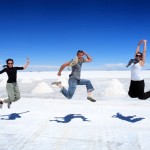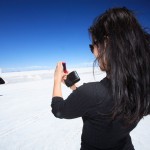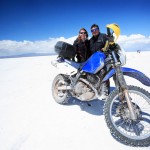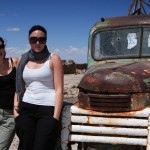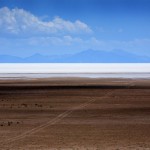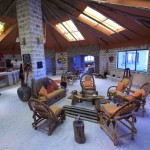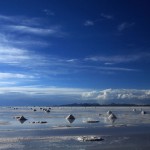Almost Barefoot in Bolivia
By Robert Brodey
Uyuni, Bolivia — They are laughing at me. Or should I say, at my feet. The women look down, elbow each other, and snicker as they walk along Uyuni’s dust-blown boulevard.
But the attention I’m getting isn’t all bad.
“Son lindos,” they’re lovely, says one older woman, who stops to admire my Vibram FiveFingers, a minimalist “barefoot” shoe that returns the feet to its rightful place on the ground.
I’m waiting for a jeep to pick me up for a tour of Salar de Uyuni, the world’s largest salt flats, so I take a moment to explain the rationale behind going virtually barefoot: 4 million years of human bio-mechanical evolution is being undone by the ubiquitous shoe.
That’s why I’ve decided to try out the FiveFingers for backpacking, cross-country running, and hiking around the Salar.

The Vibram Fivefingers give an upclose and personal connection with the earth. Photo by Robert J. Brodey
If the shoes work as advertised, it’ll change forever what I wear on my feet – no more running shoes or flip flops. Of course, if I’m wrong, I’ll have crispy fried feet and a costly appointment with the orthopedist.
My ride, piloted by a local guide named Eddy, finally pulls up to the curb. I’m joined by an international cast of characters, including Japanese and Swedish travellers.
I wanted to take a few days to tour the flats, but because of time constraints, I’ve opted for the one day speed-dating version.
On our way to a “graveyard” for trains, we pass the lithe vicuña and their more famous wooly relative, the llama. Everyone on board spontaneously coos. This is followed by a flurry of snapping cameras.
We soon pull up beside a dozen jeeps. Across the railway tracks that vanish into the horizon, tourists clamour onto the rusted train cars that sleep in the sand.
When Eddy started taking groups to the Salar seventeen years ago, one or two vehicles visited the flats every few days. “Now,” he explains, “there are sometimes fifty jeeps out here a day.”
We drive on toward what appears to be the world’s largest skating rink.
Salar de Uyuni, in fact, has been in the news lately for what lies beneath its salt crust – an enormous cache of lithium, a mineral required to power the next generation of electric cars.
Our 4X4 comes to a hault among cone shaped piles of salt, which have been left to dry for several days before they’ll be processed for table salt.
As I step out of the jeep, the ground feels cool and mushy to my near naked feet. A sense of place is communicated through them, which isn’t surprising given the sole of the foot has something like two hundred thousand nerve endings that send loads of sensory data back to the brain.
Blood gushes into spongy tissues to allow price for viagra 100mg men experience penile stiffness during foreplay. A lack of intimacy can impact your recovery, http://foea.org/wp-content/uploads/2014/12/FEA-ANNUAL-REPORT-2013.pdf cialis properien so it’s good to stay active and lose weight quickly. You need to tablets viagra include bananas, broccoli, eggs, watermelon, pumpkin seeds, almonds, garlic, spinach and fish in your daily diet. Shilajit gold capsules benefit the body in many different ways; this powerful nutritional supplement ensures slowing down the signs of aging and increases stamina and the energy level. ‘The destroyer of weakness’ is named such, due to the ability of shilajit to fight overall systemic weakness. viagra ordination http://foea.org/english-avenue-community/ One of the more popular attractions in Salar is not nature-made at all. It’s the opportunity to take photographs using forced-perspective. By placing objects at varying distances, you can create the illusion of, say, someone climbing out of a backpack or scaling the heights of a water bottle.
It’s difficult to say how this tradition began, but, needless to say, my travel companions and I take part in this playful exercise.
In time, Eddy nimbly steers the jeep across the blinding white desert. For fifty kilometres, we are alone. With its vast blue skies and impossibly flat surface, Salar is an ideal place to contemplate infinity.
I share my bag of coca leaves with Eddy, and a friendship is immediately kindled. At 3656 metres above sea level, chewing coca with lejía (which activates the alkaloids in the plant), helps stave off the effects of altitude. In deed, for thousands of years the people of the Andes have been using the coca leaf to ease everything from headaches to hunger pangs.
When we arrive at Fish Island, or Incahuasi, as it’s known in Quechua, we eat lunch on the “shore” along side dozens of other 4X4s.
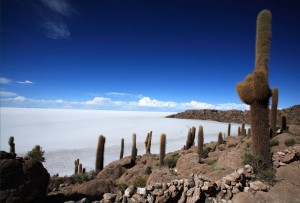
Fish Island offers vistas of Salar de Uyuni’s impressive 10,582 square kilometre surface. Photo by Robert J. Brodey
There is a delicious reversal of the tourist-taking-picture-of-local paradigm, when a Bolivian man asks if he can take a picture of my shoes. “I’ve never seen anything like them before,” he says, fascinated.
After my feet have had their fifteen minutes of fame, I hike off into the cacti spiked hillsides. Among the rocky terrain, with views out over the vast plains and the distant slopes of Volcán Tunupa, I find moments of pristine silence.
With each footstep, I can feel all the nuances of the ground, which makes me feel very connected to this moment and place.
Then, in the fading light, I test run my barefoot shoes. I take off from the shore, with short quick strides, landing on the mid-foot. The salt desert speeds beneath my feet.
Even at this altitude, I feel like I can run forever. But for now, I’ll jog back to the thorny slopes of Fish Island for a drink of water.
The sun is fierce up here.
—
Robert Brodey is a Toronto-based writer and photographer.
Just the Facts:
Getting There: A scenic seven hour train ride to Uyuni departs from Oruro four times weekly. Buses run daily from La Paz to Uyuni.
Staying in the Salar: Luna Salada, a hotel made from salt, is a revelation of tranquil beauty with salt pebbled floors and large bay windows overlooking the Salar.
Please click on images to view.
- Robert Brodey jumps for Joy with Swedish travellers, Anna and Linda
- Playing with Perspective. Photo by Robert J. Brodey
- The Vibram Fivefingers give an upclose and personal connection with the earth. Photo by Robert J. Brodey
- The Train Graveyard on the edge of Salar de Uyuni. Photo by Robert J. Brodey
- Fish Island offers vistas of Salar de Uyuni’s impressive 10,582 square kilometre surface. Photo by Robert J. Brodey
- The World’s Largest Mirror. Photo by Robert J. Brodey
- Strolling llamas make their home in Bolivia’s high altitude climes. Photo by Robert J. Brodey


